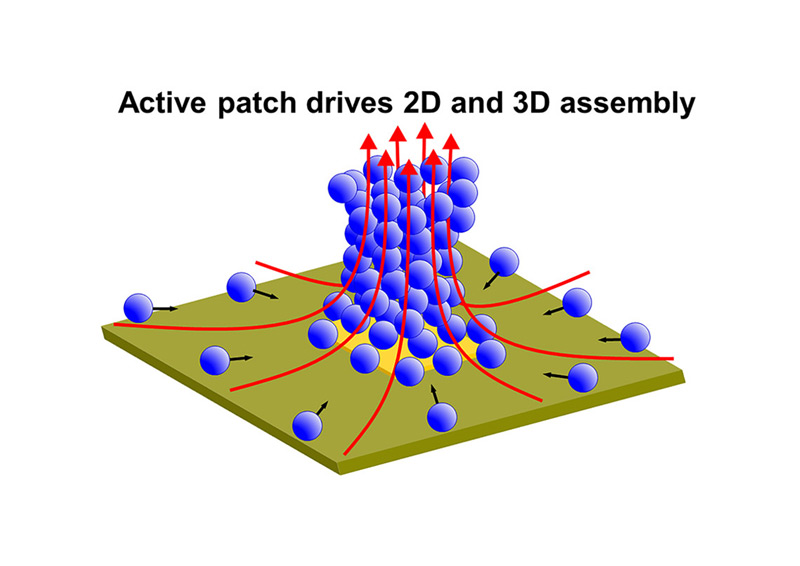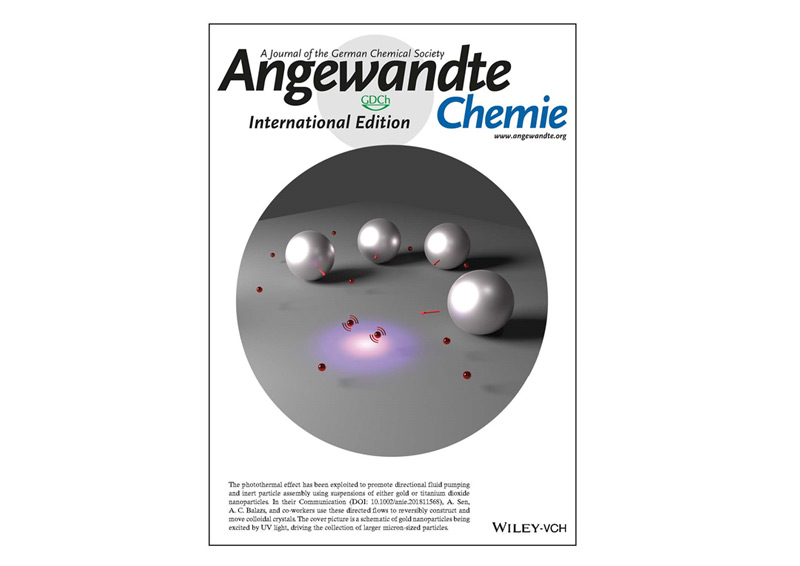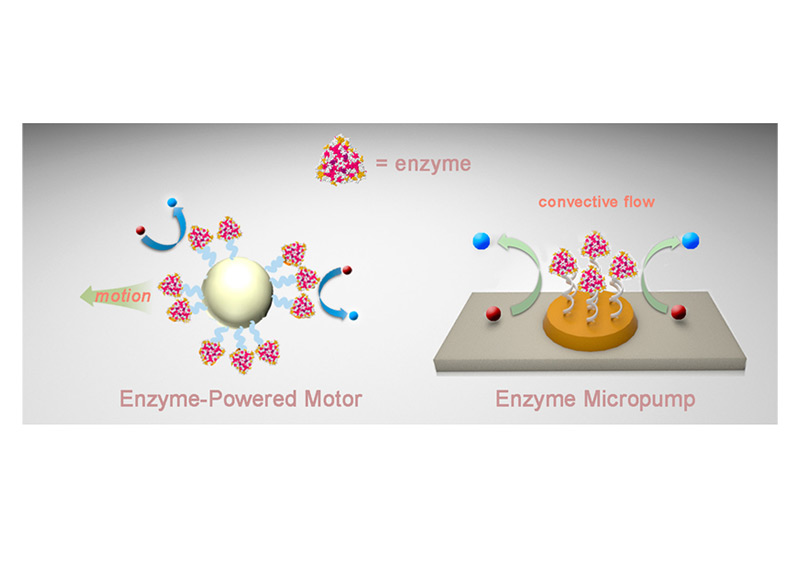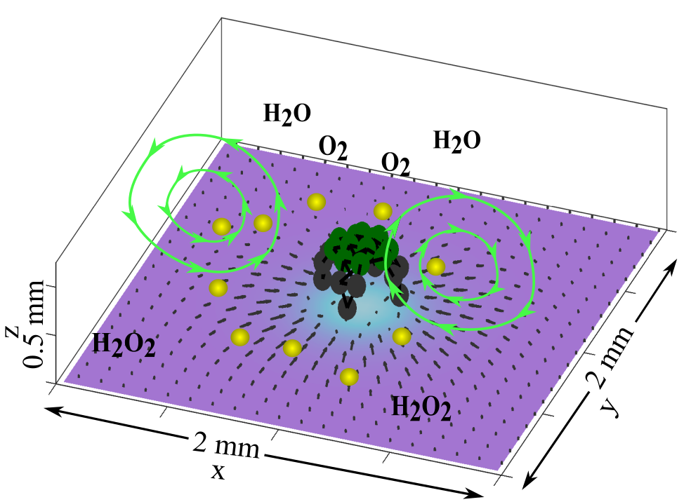Publications
References
1. Shum, H., Balazs, A.C., “Flow-Driven Assembly of Microcapsules into Three-Dimensional Towers,” Langmuir34(8) (2018) 2890-2899.
2. Zhao, X., Gentile, K., Mohajerani, F., Sen, A., “Powering Motion with Enzymes,” Accounts of Chemical Research 51 (2018) 2373-2381. (DOI:10.1021/acs.accounts.8b00286)
3. Maiti, S., Shklyaev, O.E., Balazs, A.C., Sen, A., “Self-Organization of Fluids in a Multi-enzymatic Pump System,” Langmuir35 (2019) 3724-3732.
4. Shklyaev, O.E., Shum, H., Balazs, A.C., “Using Chemical Pumps and Motors to Design Flows for Directed Particle Assembly,” Accounts of Chemical Research51 (2018) 2672–2680.
5. Yang, F., Rallabandi, B., Stone, H.A., “Autophoresis of two adsorbing/desorbing particles in an electrolyte solution,” Journal of Fluid Mechanics865 (2019) 440-459.
6. Santa Chalarca, C.F., Letteri, R.A., Perazzo, A., Stone, H.A.,Emrick, T., “Building supracolloidal fibers from zwitterion-stabilized adhesive emulsions,” Advanced Functional Materials28(45) (2018) 1804325, 10 pages.
7. Tansi; B.M., Peris, M.L., Shkylaev, O.E., Balazs, A.C., Sen, A., “Organization of Particle Islands Via Light-Powered Fluid Pumping,” Angewandte Chemie131 (2019) 2317-2321.
8. Manna, R.K., Shklyaev, O.E., Kauffman, J., Tansi, B., Sen, A., Balazs, A.C., “Light-Induced Convective Segregation of Different Sized Microparticles,” ACS Appl. Mater. Interfac.11 (2019) 18004-18012. (DOI: 10.1021/acsami.9b03089)
9. Laskar, A., Shklyaev, O.E., Balazs, A.C., “Designing Self-propelled, Chemically Active Sheets: Wrappers, Flappers and Creepers,” Sci. Adv. 4 (2018) eaav1745, 11 pages.
10. Laskar, A., Shklyaev, O.E., Balazs, A.C., “Collaboration and competition between active sheets for self-propelled particles,” PNAS116 (2019) 9257-9262.
11. Liu, Y., Rallabandi, B., Zhu, L., Gupta, A., Stone, H.A., “Pattern formation in oil-in-water emulsions exposed to a salt gradient,” Physical Review Fluids4 (2019) 084307, 18 pages.
12. Pack, M.Y., Yang, A., Perazzo, A., Qin, B., Stone, H.A., “The role of extensional rheology on droplet bouncing,” Physical Review Fluids, 4, (2019) 123603. (DOI: 10.1103/PhysRevFluids.4.12360)
13. Xue, N., Pack, M., Stone, H.A., “Marangoni-driven film climbing on a draining pre-wetted film,” Journal of Fluid Mechanics, 886 (2020) A24-1. (DOI: 10.1017/jfm.2019.1071)
14. Balazs, A.C., Fischer, P., Sen, A., “Intelligent Nano/Micromotors: Using Free Energy to Fabricate Organized Systems Driven Far from Equilibrium,” Guest Editorial for the Accounts of Chemical Research special issue on “Fundamental Aspects of Self-Powered Nano- and Micromotors,” Acc. Chem. Res. 51 (2018) 2979-2979. (DOI: 10.1021/acs.accounts.8b00511)
15. Ghosh, S., Mohajerani, F., Son, S., Velegol, D., Butler, P.J., Sen, A., “Motility of Enzyme-Powered Vesicles,” Nano Lett.19 (2019) 6019-6026. (DOI: 10.1021/acs.nanolett.9b01830)
16. Somasundar, A., Ghosh, S., Mohajerani, F., Massenburg, L.N., Cremer, P.S., Velegol, D., Sen, A., “ Positive and Negative Chemotaxis of Enzyme-coated Liposome Motors,” Nature Nanotech 14 (2019) 1129-1134.
17. Laskar, A., Manna, R.K., Shklyaev, O.E., Balazs, A.C., “Modeling the Biomimetic Self-organization of Active Objects in Fluids,” Nano Today, 29 (2019) 100804, 4 pages. (DOI: 10.1016/j.nantod.2019.100804)
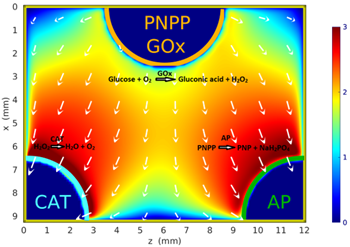
Self-organization of Fluids in a Multi-enzymatic Pump System
Subhabrata Maiti, Oleg E. Shklyaev, Anna C. Balazs, and Ayusman Sen. Langmuir, 35, 3724 (2019)
A network of three chemically coupled enzymatic pumps organized in a triangular arrangement, produces fluid streams which transport chemicals and the submerged cargo to specific locations. The highly coordinated spatio-temporal interactions among the pumps enable the network to perform as a fluidic “circuit”.
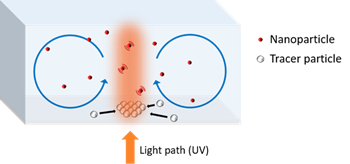
Organization of Particle Islands Via Light-Powered Fluid Pumping
Benjamin M. Tansi, Matthew L. Peris, Oleg E. Shklaev, Anna C. Balazs, and Ayusman Sen. Angew. Chem., Int. Ed. 58, 2295 (2019).
When gold nanoparticles within a fluid-filled microchamber are irradiated with UV light, the energy is dissipated into heating the solution, which consequently undergoes convective motion. The buoyancy-generated flow can be harnessed to aggregate sedimented microparticles into colloidal clusters and relocate them within microchambers.
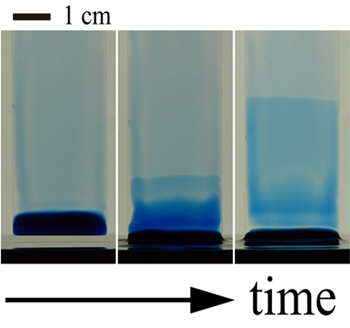
Marangoni-driven Film Climbing on a Draining Pre-wetted Film.
Nan Xue, Min Pack and Howard A. Stone, J. Fluid Mech, in press (2019).
We reported a Marangoni flow generated when a bath of surfactant contacts a pre-wetted, clean, film on a vertical substrate. Higher surfactant concentration induces a faster and thicker climbing film, which increases for thicker pre-wetted films. In contrast, for low surfactant concentrations, where Marangoni driving balances with gravitational drainage, increasing the film thickness decreases the rise speed of the climbing front while enhancing gravitational drainage. A model was established to analyze the climbing front, either in the Marangoni driving dominated region or in the Marangoni balanced, drainage region.
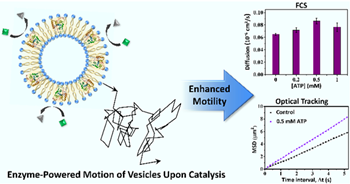
Motility of Enzyme-Powered Vesicles.
Subhadip Ghosh, Farzad Mohajerani, Seoyoung Son, Darrell Velegol, Peter J. Butler, and Ayusman Sen, Nano Lett., 2019, 19, 6019.
Autonomous nanovehicles powered by energy derived from chemical catalysis have potential applications as active delivery agents. We describe the autonomous movement of vesicles with membrane-bound enzymes in the presence of the substrate. We find that the motility of the vesicles increases with increasing enzymatic turnover rate. The membrane-bound protocells that move by transducing chemical energy into mechanical motion serve as models for motile living cells and are key to the elucidation of the fundamental mechanisms governing active membrane dynamics and cellular movement.
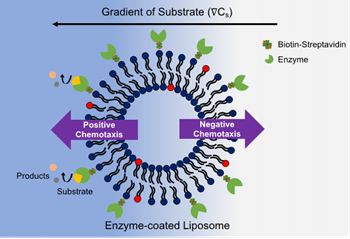
Positive and Negative Chemotaxis of Enzyme-coated Liposome Motors.
Ambika Somasundar, Subhadip Ghosh, Farzad Mohajerani, Lynnicia N. Massenburg, Tinglu Yang, Paul S. Cremer, Darrell Velegol, and Ayusman Sen, Nature Nanotech., 2019, 14, 1129 News & Views: Nature Nanotech., 2019, 14, 1091.
The ability of cells or cell components to move in response to chemical signals is critical for the survival of living systems. This motion arises from harnessing free energy from enzyme catalysis. We show both positive or negative chemotaxis of liposomal protocells. We hypothesize that the propulsion mechanism is based on the interplay between enzyme-catalysis induced positive chemotaxis and solute-phospholipid based negative chemotaxis. Controlling the extent and direction of chemotaxis holds considerable potential for designing cell mimics and delivery vehicles that can reconfigure their motion in response to environmental conditions.
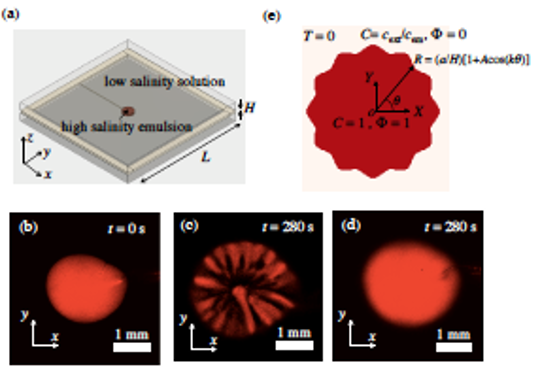
Pattern formation in oil-in-water emulsions exposed to a salt gradient.
Ying Liu, Bhargav Rallabandi, Lailai Zhu, Ankur Gupta, and Howard A. Stone. Physical Review Fluids, in press (2019).
We experimentally show that an oil-in-water emulsion exposed to salt concentration gradients generates a flower-like pattern driven by vertical and azimuthal buoyancy-driven instabilities. We also report numerical and analytical studies to elaborate on the mechanism, the instability criteria, and the most unstable modes that determine the details of the observed patterns.
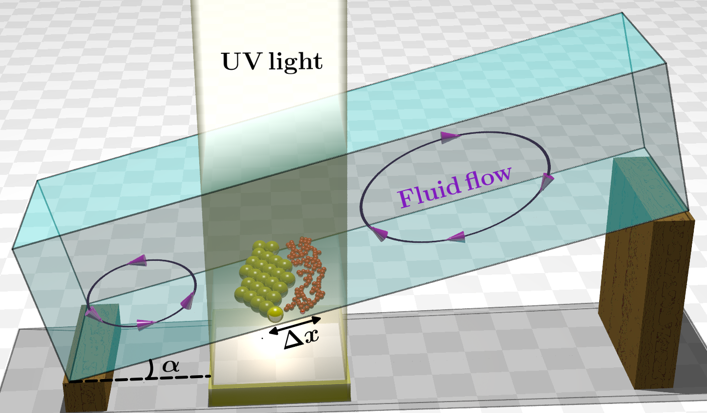
Light-induced Convective Segregation of Different Sized Microparticles
Raj Kumar Manna, Oleg E. Shklyaev, Joshua Kauffman, Benjamin Tansi, Ayusman Sen, Anna C. Balazs. ACS Appl. Mater. Interfaces 11, 18004 (2019).
The convective flows generated within an inclined microchamber via irradiation with the UV-light can be harnessed to separate microparticles with different size and/or density.
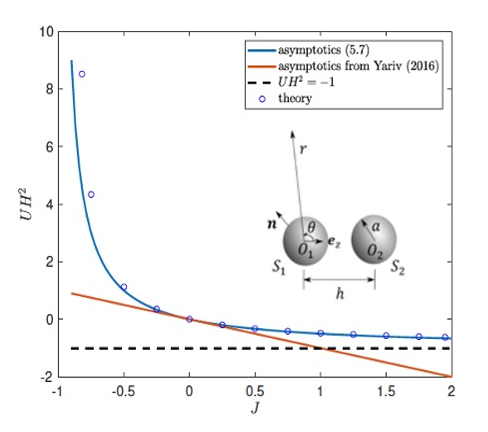
Autophoresis of two adsorbing/desorbing particles in an electrolyte solution.
Fan Yang, Bhargav Rallabandi and Howard A. Stone. Journal of Fluid Mechanics. 865, 440-459 (2019)
We investigated the autophoresis of two particles in an electrolyte solution where the concentration gradient is produced by either adsorption or desorption of ions at the particle surfaces. In particular, we showed that the phoretic velocity saturates at a finite value for large desorption fluxes, but depends superlinearly on the flux for adsorption fluxes, where both conclusions are in contrast with previous results that predict a linear relationship between autophoretic velocity and the sorption flux.
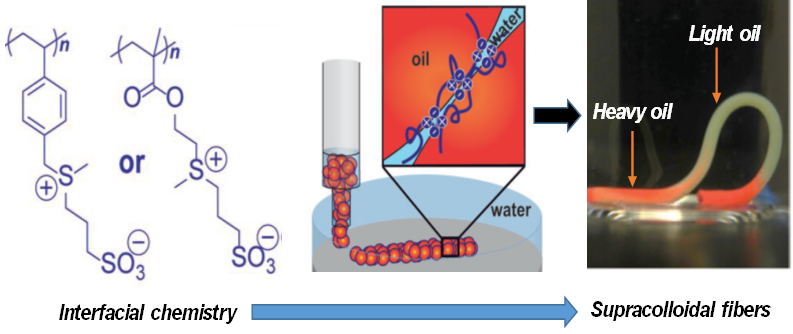
Building supracolloidal fibers from zwitterion-stabilized adhesive emulsions.
Santa Chalarca, C.F.; Letteri, R.A.; Perazzo, A.; Stone, H.A.; Emrick, T. Advanced Functional Materials, 28, Article 1804325 (2018)
“Sticky droplets” containing novel polymer zwitterions bridging the fluid-fluid (oil-water) interface produce chemically reconfigurable soft structures (or “supracolloidal fibers”). CCMA researchers are working to add reactive functionality to these polymers/droplets in order to tailor chemomechanical properties of the resultant fibers.
Using Chemical Pumps and Motors To Design Flows for Directed Particle Assembly
These findings facilitate the fabrication of stand-alone microfluidic devices that autonomously perform multistage chemical reactions and assays for portable biomedical applications and act as small-scale factories to autonomously build microscale components.
Oleg E. Shklyaev, Henry Shum, and Anna C. Balazs • Acc. Chem. Res., 2018, 51 (11), pp 2672–2680 • DOI: 10.1021/acs.accounts.8b00234
Organization of Particle Islands via Light-Powered Fluid Pumping
New method uses ultraviolet light to control fluid flow and organize particles.
Benjamin M. Tansi, Matthew L. Peris, Oleg E. Shklyaev, Anna C. Balazs, Ayusman Sen. Organization of Particle Islands Via Light-Powered Fluid Pumping. Angewandte Chemie International Edition, 2018; DOI: 10.1002/anie.201811568
Powering Motion with Enzymes
A detailed understanding of how enzymes convert chemical energy to directional mechanical force can lead us to the basic principles of fabrication, development, and monitoring of biological and biomimetic molecular machines.
Xi Zhao, Kayla Gentile, Farzad Mohajerani, and Ayusman Sen • Acc. Chem. Res., 2018, 51 (10), pp 2373–2381 • DOI: 10.1021/acs.accounts.8b00286
Collaboration and Competition between Active Sheets for Self-propelled Particles
Catalyst-coated flexible sheets, which resemble crabs, convert reactants in solution into products, and thereby create local variations in the density and chemical composition of the fluid. The resulting buoyancy-driven convective flows compete with the diffusiophoretic self-propulsion of submerged particles and enables the system to mimic the biologically relevant behavior where sheets (“crabs”) catch particles (“food”).
Abhrajit Laskar, Oleg E. Shklyaev, Anna C. Balazs. Proc. Natl. Acad. Sci. USA 116, 9257 (2018).
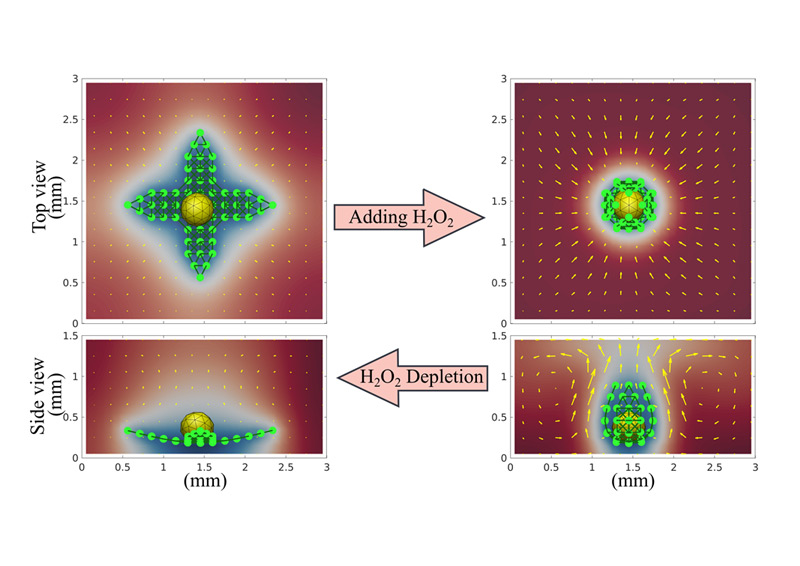
Designing self-propelled, chemically active sheets: Wrappers, flappers, and creepers
These studies reveal how to achieve both spatial and temporal controls over the position and shape of active sheets and thus use the layers to autonomously and controllably trap soft objects, perform logic operations, and execute multistage processes in fluid-filled microchambers.
Abhrajit Laskar, Oleg E. Shklyaev, and Anna C. Balazs • Science Advances 21 Dec 2018: Vol. 4, no. 12, eaav1745 • DOI: 10.1126/sciadv.aav1745

Fundamental Aspects of Self-Powered Nano- and Micromotors
Accounts of Chemical Research special issue on “Fundamental Aspects of Self-Powered Nano- and Micromotors” Guest Editors: Anna Balazs, Peer Fischer, and Ayusman Sen
Editorial: Intelligent Nano/Micromotors: Using Free Energy To Fabricate Organized Systems Driven Far from Equilibrium
Anna C. Balazs, Peer Fischer, and Ayusman Sen. Acc. Chem. Res., 2018, 51 (12), pp 2979–2979. DOI: 10.1021/acs.accounts.8b00511
